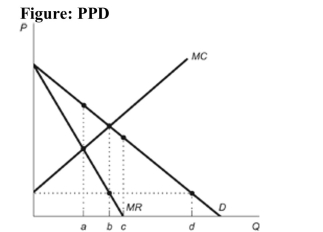Multiple Choice
 Reference: Ref 14-3 (Figure: PPD) Refer to the figure. Which of the following statements best explains why a firm that perfectly price discriminates would sell additional units beyond c units of output?
Reference: Ref 14-3 (Figure: PPD) Refer to the figure. Which of the following statements best explains why a firm that perfectly price discriminates would sell additional units beyond c units of output?
A) If the firm can perfectly price discriminate it can charge a price equal to the consumers' willingness to pay, which for all units beyond c is higher than the firm's marginal cost for those units.
B) The firm will continue to increase profits as long as consumers' willingness to pay is greater than zero.
C) A firm will not sell beyond c units of output. The marginal cost is greater than consumers' willingness to pay for these units.
D) A firm will not sell beyond c units of output. The marginal cost is greater than the firm's marginal revenue for these units.
Correct Answer:

Verified
Correct Answer:
Verified
Q9: A perfect price-discriminating seller:<br>A) cannot prevent arbitrage.<br>B)
Q43: One example of price discrimination occurs in
Q76: Figure: Monopolist <img src="https://d2lvgg3v3hfg70.cloudfront.net/TB3375/.jpg" alt="Figure: Monopolist
Q79: <img src="https://d2lvgg3v3hfg70.cloudfront.net/TB3375/.jpg" alt=" Reference:
Q82: <img src="https://d2lvgg3v3hfg70.cloudfront.net/TB3375/.jpg" alt=" Reference: Ref 14-6
Q85: Pfizer sells Atgam in New Zealand for
Q115: One would expect more arbitrage to occur
Q124: Pharmaceuticals with high fixed costs can benefit
Q194: Price discrimination may be:<br>A) good in industries
Q253: Which of the following statements is TRUE